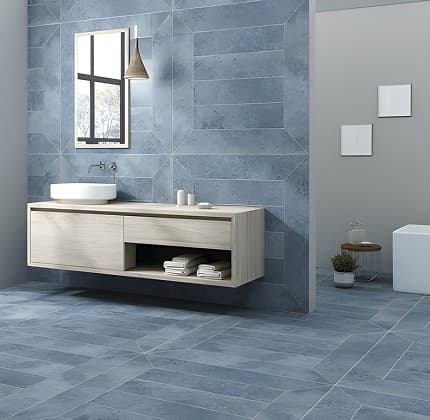
Modern Bathroom Tiles in Bangladesh: Styles, Price, and Design Tips
23 Oct, 2025
Searching for modern bathroom tiles in Bangladesh that look stunning, clean easily, and fit a smart budget? From glossy porcelain that brightens small flats to matte stone looks that bring spa calm, the right tile can transform your washroom fast. With so many sizes, finishes, and brands, how do you choose what lasts and still feels current?
Today, in this blog, we’ll explain every aspect of bathroom tile design, from the types, prices, and additional tips to the designs you should consider for your bathroom floor and walls.
So, without further ado, let’s get started.
Why is Choosing the Right Bathroom Tiles Crucial?
You might think getting and installing tiles with random designs and patterns would be good. However, that’s definitely not the case! Here are some crucial reasons why you should be serious about choosing the right tiles for your bathroom.
- Safety in wet zones: Wet floors get slippery fast. Choose matte or lightly textured tiles with good grip for the floor, especially in the shower area. Smaller floor tiles with more grout lines can improve traction and help drainage on sloped surfaces.
- Moisture resistance and durability: Porcelain with low water absorption suits floors and wet walls because it resists swelling and staining. Glazed ceramic works well on dry walls. For heavy foot traffic, check wear ratings suited to floor use.
- Easy cleaning and hygiene: Smooth glazed surfaces resist soap scum and stains. Pick quality grout and seal it, or use epoxy grout to block mold. Fewer but well-planned grout joints make cleaning simpler without compromising the slope in the shower.
- Actual cost of ownership: Cheaper tiles that chip or absorb water end up costing more through repairs and regrouting. Buy a little extra, around 5 to 10 percent, for cuts and future repairs, so replacements match.
- Space and light magic: Light colors and glossy wall tiles bounce light and make small washrooms feel bigger. Matte floors reduce glare and slip risk. Large formats minimize visual clutter, while vertical layouts can make low ceilings feel taller.
- Climate fit for Bangladesh: High humidity and frequent mopping demand tiles that handle moisture well. Prioritize dense bodies, good glazing, and proper waterproofing behind the tiles to prevent damp patches and efflorescence.
Available Types of Bathroom Tiles in Bangladesh
You’ll find a sea of options for your bathroom tiles. Here are some popular types of bathroom tiles that are widely used in Bangladesh. All of them are available at your nearest outlets.
1. Ceramic Tiles
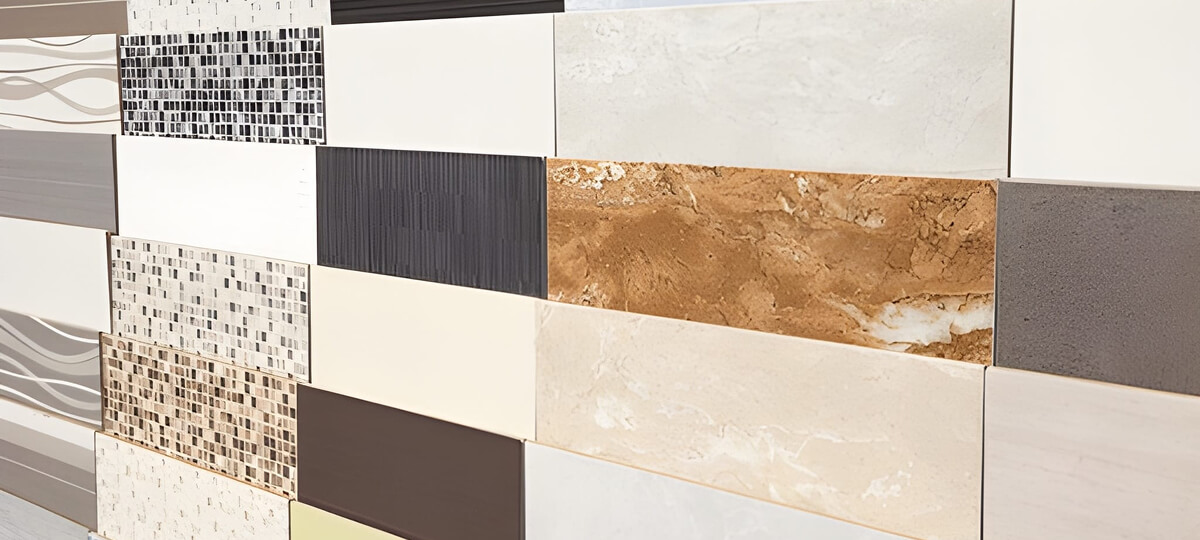
Ceramic tiles are the everyday hero for Bathrooms. And the most unique thing about ceramic tiles is that they come with endless designs and patterns with unique non-porous properties. They resist hard stains and moisture, preventing moss. You’ll get them in versatile designs, textures, and colors at affordable costs.
2. Porcelain Tiles
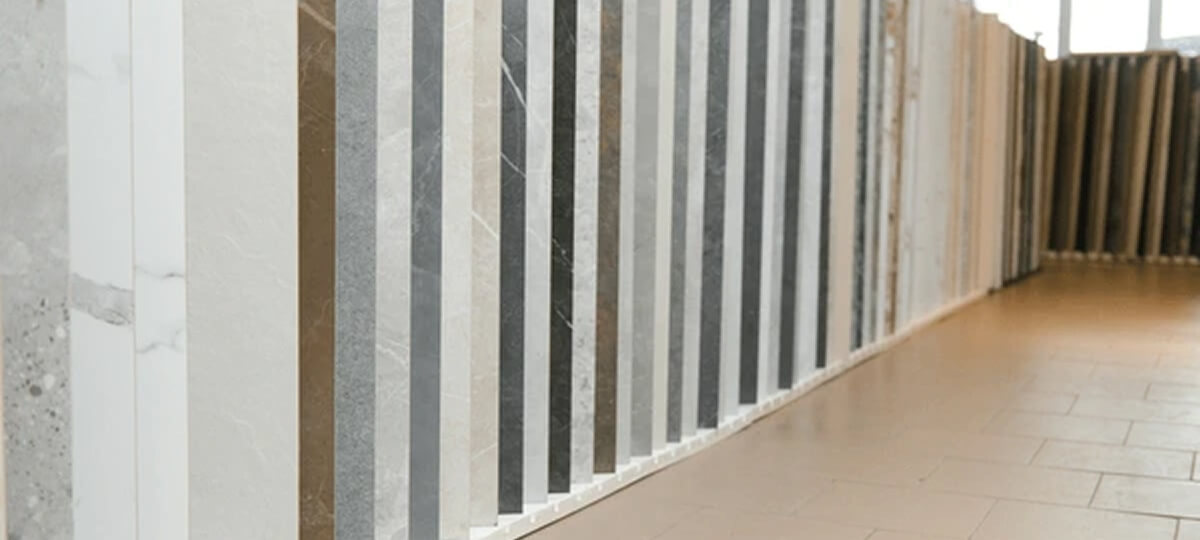
Porcelain tiles are more durable, denser, and less porous than ceramic tiles. So, they are perfect for your bathroom floor as they can handle frequent stepping on them. You’ll get them in both polished and matte finishes. As matte finish porcelain tiles offer a better grip, you can use them for your bathroom floor. If you are a fan of marble, granite, or even a wooden finish, you can also get porcelain tiles with those designs.
3. Marble Tiles
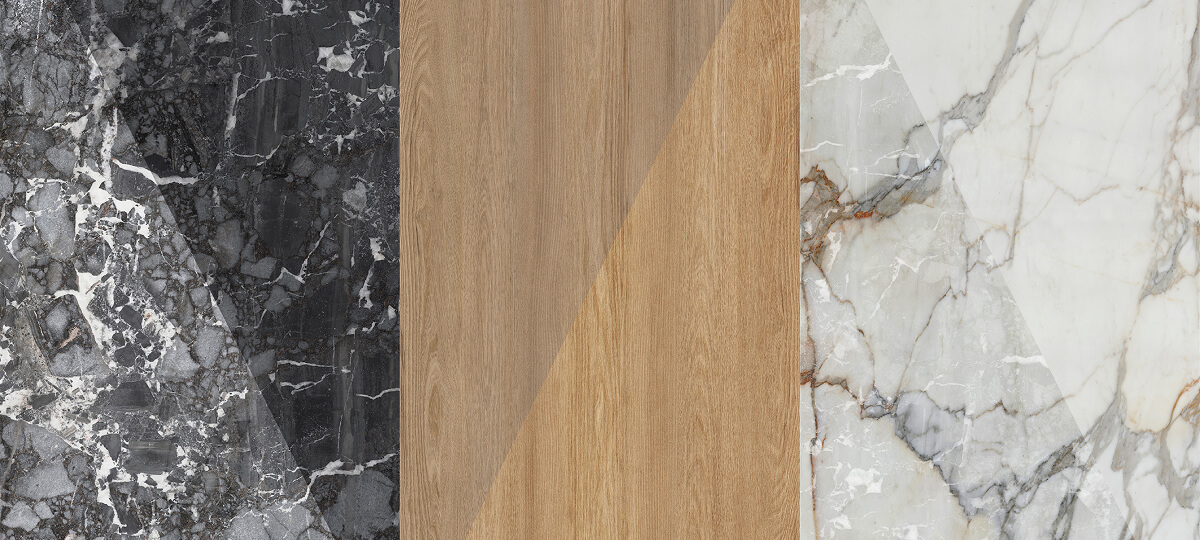
Marble tiles are the elements that unlock timeless luxury in your bathroom. They bring a spa-like vibe and add a distinctive elegance that seamlessly blends with the aesthetics. The only pitfall is that they need added maintenance to retain their natural elegance and to prevent staining from moisture and soaps. You’ll get marble tiles for your bathroom almost everywhere in Bangladesh. It might cost a little more compared to ceramic and porcelain options.
4. Mosaic Tiles

If you want to add character to your bathroom, mosaic tiles are your answer. These small tiles, made from ceramic, glass, or stone, can be arranged into colorful patterns or subtle designs. They’re perfect for accent areas like niches, mirrors, or shower walls.
Bathroom Tiles Price in Bangladesh
How much should be considered for the bathroom tiles? Well, the bathroom tile price depends on multiple factors such as brands, building materials, designs, textures, types, and the finish you choose.
For instance, ceramic tiles start at BDT 40 per square foot, which is a budget-friendly, durable option. On the other hand, porcelain tiles cost between BDT 90 and BDT 250 per square foot. If timeless elegance is your priority and you can see marble tiles as a suitable option, you’ll need to consider the BDT 250 to BDT 700 price range.
We performed extensive research on bathroom tile pricing in Bangladesh and created the table below. It will give you a clear idea of how your budgeting should be for your bathroom-
| Tile Type | Common Sizes (inch) | Average Price Range (BDT per sq. ft) | Best Use |
|---|---|---|---|
| Ceramic Tiles | 12×12, 12×18, 16×16 | 40 - 120 | Walls, low-traffic floors |
| Porcelain Tiles | 12×24, 16×32, 24×24 | 90 - 250 | Floors, shower areas |
| Vitrified Tiles | 24×24, 24×48 | 150 - 350 | Premium walls and floors |
| Marble Tiles | 12×12, 24×24 | 250 - 700 | Feature walls, vanity areas |
| Granite Tiles | 12×12, 24×24 | 300 - 800 | Floors, countertops |
| Mosaic Tiles | Variable pattern sizes | 120 - 400 | Accent walls, shower niches |
Budget Planning Tip
Here’s a quick snapshot of what you can expect for a standard 40 sq. ft. bathroom floor (average size in apartments). Considering your bathroom size, the cost will vary accordingly.
| Tile Type | Avg. Price (per sq. ft) | Approx. Material Cost (BDT) | With Installation (BDT) |
|---|---|---|---|
| Ceramic | 80 | 3,200 | 4,800 - 5,000 |
| Porcelain | 160 | 6,400 | 7,800 - 8,500 |
| Vitrified | 250 | 10,000 | 11,500 - 12,500 |
| Marble | 500 | 20,000 | 22,000 - 23,000 |
Bathroom Tiles Design for Floor
In Bangladesh's humid climate, where moisture levels can spike during monsoons, selecting the right floor tile design means prioritizing slip resistance and water absorption rates below 0.5% to prevent accidents and mold growth.
Now we’ll let you see some popular designs with tiles for your bathroom floor that are gaining popularity. Let’s check them out-
1. Large neutral tiles (minimal seams)
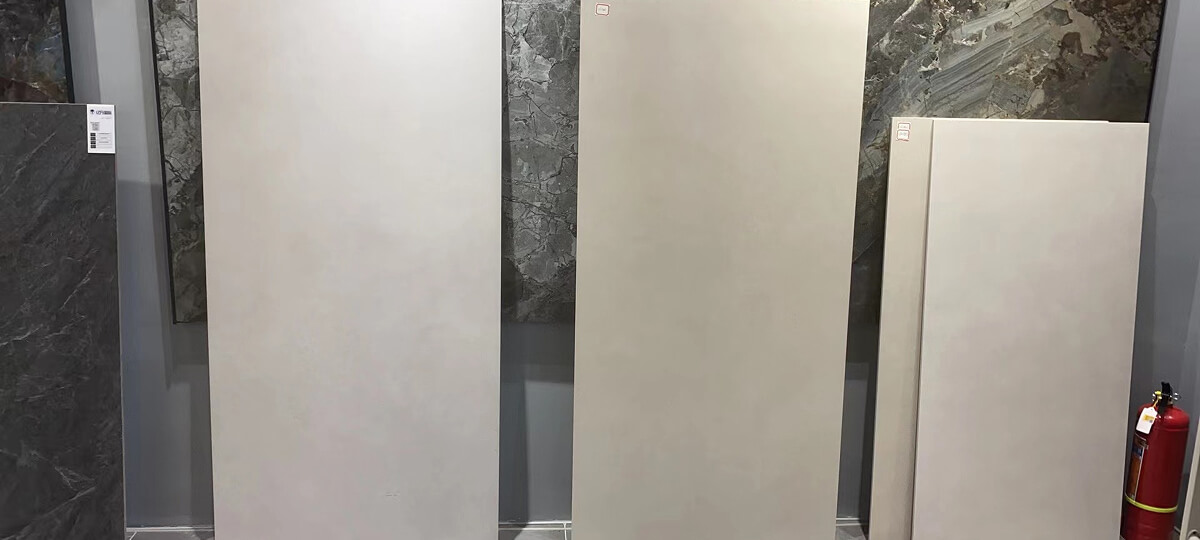
Using large format tiles for your bathroom tiles means allowing fewer grout lines. This design will make your bathroom feel spacious even though your bathroom size is moderate. You can also take advantage of neutral shades such as beige, light grey, or ivory that help bounce natural light and create an airy feel.
2. Patterned or geometric tiles (to add character)
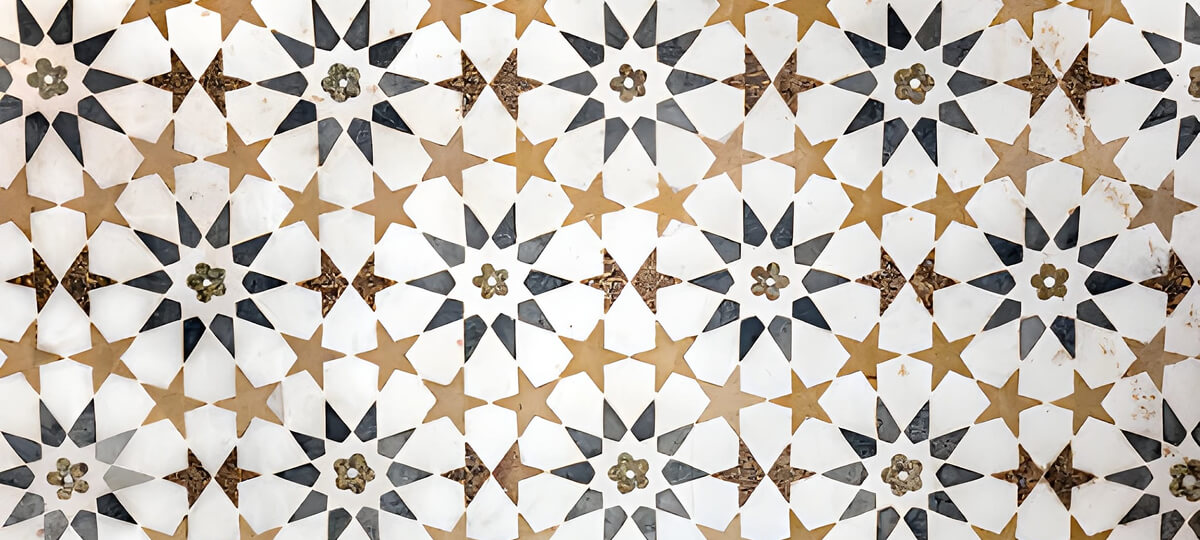
When your bathroom is too plain, patterned or geometric tiles can add character. Options like hexagonal tiles, herringbone, chevron, or Moroccan motifs introduce movement and visual interest. You can use them across the entire floor or as a centerpiece bordered by plain tiles. For smaller bathrooms, subtle geometric prints in soft colors keep the design balanced, while larger bathrooms can handle bold contrasts or intricate mosaics. And patterned tiles are ideal when you want the floor to serve as a statement feature.
3. Wood-look or warm tone tiles (texture + warmth)
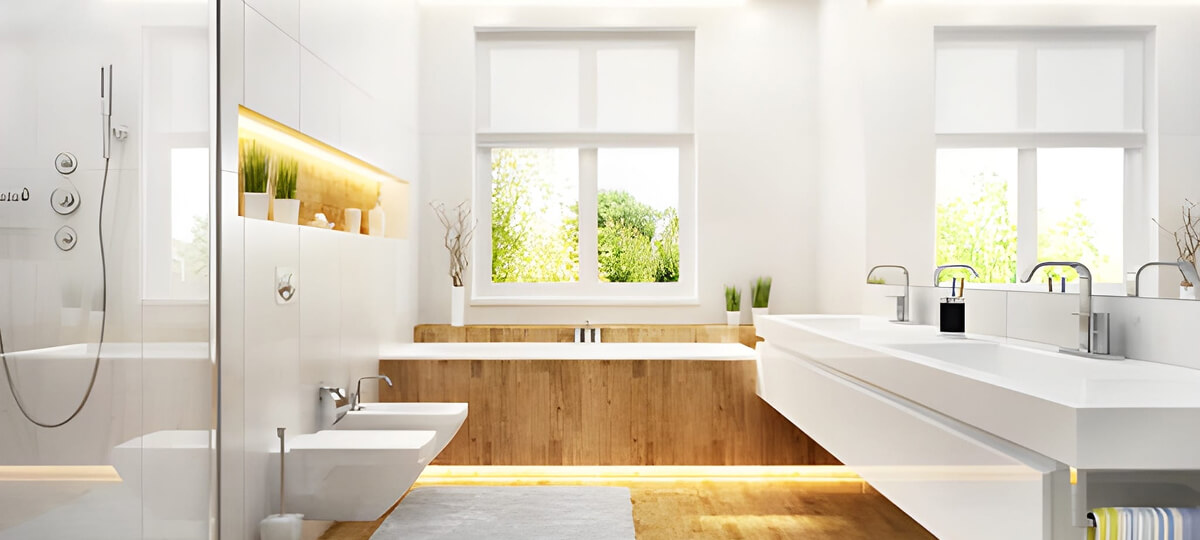
Wood-look tiles are rarely used as bathroom floor tiles. However, they add a distinctive vibe of natural wood that you might love. Porcelain or ceramic tiles that replicate natural wood bring a cozy, spa-like tone to the bathroom. They offer the charm of timber with the water resistance of tile. You can choose warm tones like honey oak, walnut, or ash for a grounded and inviting atmosphere.
4. Monochrome/black & white tile scheme

This design was mostly used in the past. But still, a black-and-white palette never goes out of style. You can go with bold contrasts like checkerboard layouts or subtle variations like white marble paired with charcoal grout. This scheme suits both vintage and modern interiors while maintaining a timeless, elegant feel.
5. Mixed-material or accent tile insert
Combining different materials or finishes can add sophistication to a bathroom floor. For example, a combination of stone-effect tiles with glossy porcelain borders introduces visual contrast without overwhelming the space. Accent mosaics or small inserts can be placed around your shower zones or vanity areas to highlight specific zones. Cross tiles could be a suitable fit here. These details not only enhance design flow but also help define functional areas, such as wet and dry zones. It’s a creative way to personalize the space while maintaining a unified overall look.
Bathroom Tile Design for Walls
Your bathroom walls are more than just a background. After installing floor tiles, you should pay attention to selecting the right tiles with the right designs and patterns that complement the design of your bathroom floor. Here are some ideas to help you design walls that look beautiful and feel balanced-
1. Glossy Finish for Light and Cleanliness

If your bathroom feels a bit dark or cramped, glossy tiles can brighten things up. Their reflective surface bounces light around the room, making it appear larger and fresher. They also resist stains and are easy to wipe clean, which is perfect for areas near the sink or shower. For the best result, use soft lighting so the surface shines gently without feeling harsh.
2. Matte and Textured Tiles for Depth
For a calmer and more natural vibe, matte or textured tiles can work wonders. They soften light instead of reflecting it, creating a relaxing atmosphere. You might try stone, concrete, or linen-like finishes to give your bathroom a cozy, spa-style feel. Another plus is that they hide watermarks and fingerprints better than glossy tiles.
3. Vertical Layouts to Enhance Height

If your bathroom ceiling feels low, you can make it look taller by using long rectangular tiles placed vertically. This layout draws the eye upward, adding a sense of height and openness. It works exceptionally well in shower walls or smaller bathrooms where space feels limited.
4. Accent Walls for Visual Focus
An accent wall is a simple way to give your bathroom character. Choose one wall, like behind the vanity or bathtub, and use a different texture or pattern to create a focal point. You can consider using wave tiles to complement the overall setup. It could be a subtle color contrast or a mosaic design that adds luxury. Keeping the other walls neutral helps the accent wall stand out without feeling overpowering.
5. Neutral and Natural Shades for Harmony
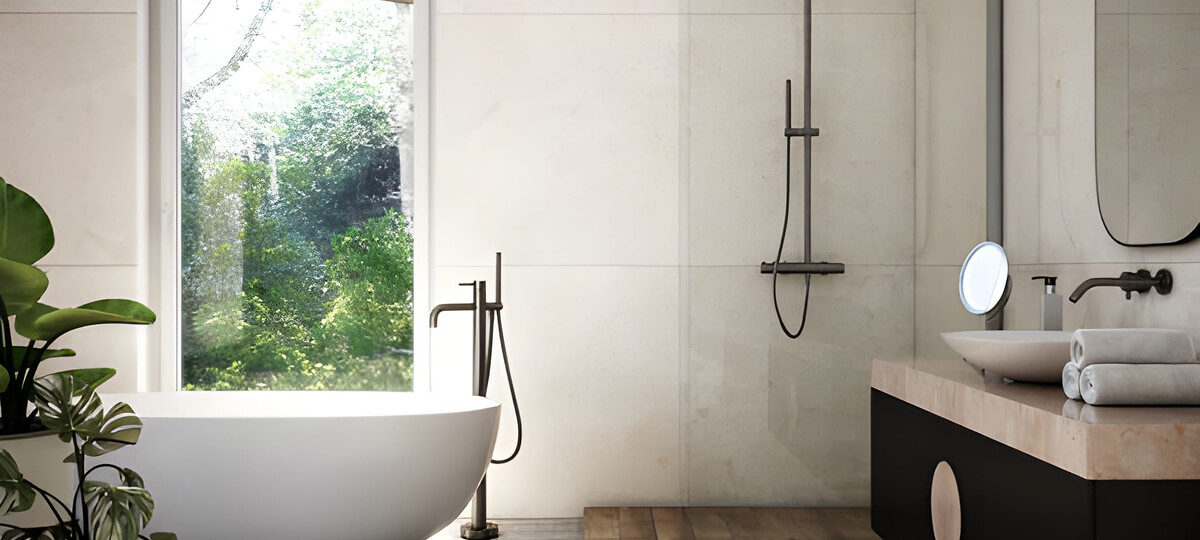
Soft neutral colors such as white, beige, or light grey never go out of style. They make your bathroom look clean and spacious while blending easily with any floor tile design. You can explore earthy tones like pale terracotta or cream if you like warmth. These pair nicely with wooden or matte black accessories, giving your bathroom a modern yet grounded look.
6. Pattern and Mosaic Inserts for Detail
If you want a bit of flair without going overboard, mosaic inserts or narrow patterned strips are a great choice. You can place a horizontal strip at eye level or a vertical design near the shower area. These small details bring rhythm and interest to your walls while keeping the overall look elegant.
Ending Note
There are mainly two parts of your bathroom for tiling - the walls and floor. The rule of thumb is that the design and pattern for both walls and floors should complement each other. The natural light projection pattern, inner lighting condition, the design of the bathroom vanity, and some other crucial factors determine the overall design of the bathroom tiles.
If you feel stuck, you can ask a professional to visit your bathroom in person, note down necessary data, and then suggest some appropriate designs. You can choose the desired one from the list and bring a serene ambience to your bathroom.
Frequently Asked Questions (FAQ)
1. Which tiles are best for a bathroom?
The best tiles for bathrooms combine slip resistance, low water absorption, and easy maintenance. Glazed porcelain and ceramic tiles are the most popular choices because they handle humidity well and come in various finishes. Matte or textured tiles work best for floors as they offer better grip. Glossy tiles are ideal for walls since they reflect light and are easy to clean.
2. What size are the tiles in Bangladesh?
In Bangladesh, bathroom tiles are available in several standard sizes. The most common floor tile sizes include 12x12 inches (300x300 mm), 16x16 inches (400x400 mm), and 24x24 inches (600x600 mm). For walls, the usual options are 10x15 inches (250x375 mm) and 12x18 inches (300x450 mm). Larger formats are becoming more popular because they reduce grout lines and make bathrooms look more spacious.
3. Which is better, 60x60 or 40x40 tiles?
Both are good choices, but it depends on the size and layout of your bathroom. 60x60 tiles create a seamless, modern look and make smaller bathrooms appear larger due to fewer joints. 40x40 tiles are easier to install in compact or uneven spaces and provide a more traditional look. If your bathroom is medium or large, 60x60 tiles often give a cleaner and more contemporary finish.
4. Which company's tiles are best in Bangladesh?
If you are looking for a reliable and stylish option, sTiles by DBL Ceramics is one of the best choices in Bangladesh. The brand focuses on modern designs, premium materials, and precise craftsmanship. sTiles offers a vast collection of bathroom tiles, from glossy wall tiles to textured anti-slip floor tiles, ensuring quality and long-lasting performance.
5. What is the cost of 1 tile per square foot?
Bathroom tile prices in Bangladesh generally range between BDT 60 and BDT 200 per square foot, depending on the material, size, finish, and design. Ceramic tiles are usually more affordable, while glazed porcelain and designer textures are more expensive. Remember to include installation and grout expenses for a more accurate estimate when budgeting.
Related Blogs
More Insights for You
Sollicitudin adipiscing id non lorem. Sit egestas nisi amet ipsum gravida mauris aliquam. Mattis eget rutrum adipiscing iaculis.

23 Mar, 2025
Wall Decoration Ideas Beyond Wall Tiles: Decor with Creativity

08 Apr, 2025
Creative Home Decor Ideas for Small Spaces and Bengali Homes

22 Apr, 2025
Wall Interior Design Ideas: Modern Looks for a Stylish Home

23 Apr, 2025
Top 12 Duplex House Design In Bangladesh that You’ll Love

13 May, 2025
Drawing Room Decoration in Bangladesh: Your Dream, Our Idea

19 May, 2025
Smart and Affordable Office Interior Design Tips Bangladesh

22 Jun, 2025
Luxury Bedroom Interior Design: Top 8 Trends for 2025

26 Jun, 2025
Must-Have Room Decoration Items From Living Room to Bathroom

30 Jul, 2025
Modern Home Decor Ideas to Make Your Home Stand Out

31 Jul, 2025
How to Choose the Best Dinner Wagon for Your Home

04 Aug, 2025
Stylish & Functional Kitchen Design in Bangladesh

11 Aug, 2025
Home Decoration Items in Bangladesh | Where Style Meets Affordability

27 Aug, 2025
Kitchen Cabinet Design Ideas for Bangladesh

14 Sep, 2025
Tiles Design Ideas for Every Room in Bangladesh

25 Sep, 2025
Tiles Texture Ideas for Every Room in Bangladesh 2025

08 Oct, 2025
Tiles Design for Floor Ideas: Living Room, Bedroom, Kitchen, Bath

04 Nov, 2025